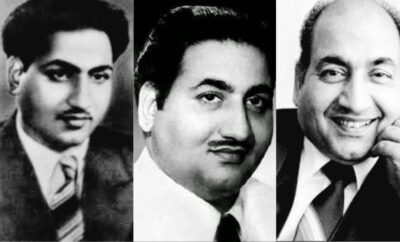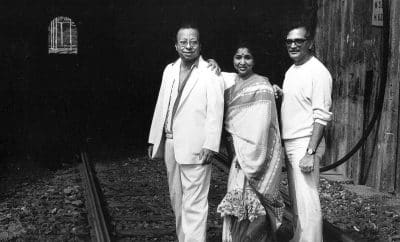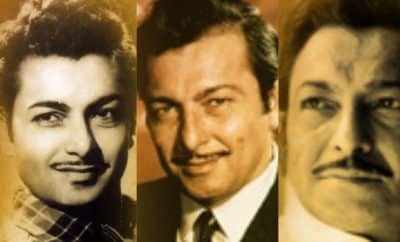Collections
Didi’s Decennial Diamonds – Lata Mangeshkar and the 7 Decades
Lata Mangeshkar – bas naam hi kaafi hai! She doesn’t need any introduction, does she? Her name is not just her name; it is the name of an era in itself, it is an identity of India, it is a synonym of music. Her entry in Hindi Film Music (HFM) revolutionised the playback singing and thereafter she has been enchanting the music lovers with her saccharine voice and divine singing without looking back. She would probably be the only exception to the rule – “you cannot please everyone”. She has been pleasing literally everyone across 5 generations over 7 decades!
On the auspicious occasion of the 90th birthday of our beloved Lata Didi (yes, it is an auspicious occasion for every HFM lover!), here is a modest attempt to wish her a happy birthday by taking a bird’s eye view of her journey in HFM through one song from each of the 7 decades (1940s to 2000s) of her active career. Here is an overview of Lata Didi’s “decennial diamonds” –
1. Aayega Aanewaalaa (Mahal – 1949)
Composed by Khemchand Prakash, penned by Nakshab and picturised on Madhubala accompanied by Ashok Kumar, the song is probably the first haunting song in Hindi films. Besides, this is the first song that gave Lataji recognition in the film industry. The record of the song had the name “Kamini” (Madhubala’s name in the film) as the name of the singer. When the song was telecast on radio, the radio stations received numerous enquiries asking for the name of the singer; and the radio stations had to then find out and announce that the song was sung by Lata Mangeshkar. And thus, the commencement of the “Lata Era” was announced! (Raj Kapoor’s “Barsaat” released in the same year was the first film to display the playback singers’ names on the records as well as on the screen.)
On the screen, the hero hears someone singing at a distance and the voice approaches him gradually. As the recording technology was not so advanced then, in order to achieve this effect, Lataji had to walk upto the mic from a distance singing the sher with which the song starts. The song did not attain the finality in one take, and Lataji kept on walking from a distance to the mic singing the sher over and over again. No wonder, the fine piece of art that emerged out of this patience, commitment and dedication became a major hit. Alas, Khemchand Prakash passed away soon after the song was released and could not see the grand success his composition had achieved.
Can you imagine that the song was recorded on the set where the film was being shot; and not in a state-of-the-art recording studio?
2. Rasik Balmaa (Chori Chori – 1956)
Chori Chori was a musical hit by Shankar-Jaikishan and their music for the film fetched them Filmfare award for best music. Out of all the melodious and catchy songs from the film, this one leaves a long-lasting impression on our minds. The song composed by the duo in raag Shuddha Kalyan and written by Hasrat Jaipuri, is a perfect portrayal of a betrayed heart. Lataji’s rendition drenched in emotions takes the marvellous composition to the next level. Particularly, the heart-piercing stress on the word “balamaa” that Lataji gives every time makes us empathise with the distressed girl. The beautiful orchestration commensurate with the Shankar-Jaikishan style adds a wonderful aroma to the song.
Celebrated producer-director Mehboob Khan – who suffered a massive heart attack during his visit to the USA and hence could not come back to India for quite some time – called Lataji and asked her to sing “Rasik Balamaa” for him. This was repeated more than once before he recovered and returned to India. Such is the charisma of this song!
https://www.youtube.com/watch?v=WrbzqRhoSNA
3. Pyar Kiyaa To Darnaa Kyaa (Mughal-e-Azam – 1960)
The magnum opus Mughal-e-Azam was director K. Asif’s dream, which he perseverantly pursued and brought to reality after crossing a plethora of hurdles many years after its conception. It however came out to be a masterpiece in all aspects breaking various contemporary records. The film earned a lot of praise for its grandeur and music was no exception.
This song, which could be considered as the flagship song of the film, starts with a classical rendition by the renowned classical singer Bade Ghulam Ali followed by a sher in Lataji’s voice, through which the courtesan Anarkali (Madhubala) starts proclaiming her love for the Prince Saleem. After a short prelude, Anarkali becomes more and more vocal about her love with a rebellious attitude and voices that she is not afraid of death, let alone the emperor! Lataji perfectly reflects her determination through her sharp tone and suitable throw of words.
Some accounts state that Lachhu Maharaj, the choreographer of the film, acted as the body double for Madhubala in long shots wearing her mask, as she could not manage the dramatic twirls.
And thereby hangs another tale – due to lack of the necessary technology to get reverberating effect, Naushad achieved it by making Lataji sing the song in a studio bathroom.
https://www.youtube.com/watch?v=yCV03piYaZM
4. Raina Beeti Jaye (Amar Prem – 1972)
Amar Prem, a chef-d’oeuvre directed by Shakti Samanta, is studded with 6 musical gems composed by Panchamda and penned by Anand Bakshi; Raina Beeti Jaye being the most shining one!
Panchamda has seamlessly used a blend of two raags in this song – raag Todi and raag Khamaj, the favourite raag of the Burmans. Panchamda’s magic mesmerises us to the core.
It starts taking the control of our heart right from the touching piece of sarangi at the beginning and Lataji’s deep aalaap with subtle pieces of santur fluttering around it. Then follows the prelude comprising flute played by Pt. Hariprasad Chaurasia accompanied by rhythm with haunting guitar chords. Then Lataji starts with her soulful rendition and the song starts like a deep river flowing gradually but gracefully. And when it ends, you realise that you have flown with it far away and are in no mood to return.
As the song is classical based, no wonder the orchestration comprises sarangi, santur, flute, dilruba and tabla. But then you hear guitar making its presence felt clearly in the prelude and thereafter subtly throughout the song. And yet it does not look “odd man out” in the group of all the classical instruments. This is Pancham stamp! Panchamda and Marutirao Keer are known for their experimentation with rhythm; and the percussion of this song is of course not an exception. Different rhythmic patterns of taal Keherwa used in mukhdaa and the antaraa, with mild touches of maadal in mukhda keep on announcing that this is a Pancham song!
Panchamda has preferred Lataji for most of his outstanding compositions and this one deserves a rank towards the top in the list of such compositions.
https://www.youtube.com/watch?v=RRk9pG5Upe4
5. Aye Dil-e-Nadaan (Raziya Sultan – 1983)
The film, written and directed by Kamal Amrohi, is based on the speculated love affair between Razia Sultan (Hema Malini), the only female ruler of Delhi and the slave Jamal-ud-Din Yakut (Dharmendra). No wonder if the Queen lands up in an upheaval about speaking her heart out – “kah nahin sakte, kiskaa armaan hai!” And this song perfectly expresses her agitation through the amazing lyrics by Jan Nisar Akhtar.
And when it comes to the composition – it’s such a Khayyam song! Just like his other tunes, this tune too has those magical Khayyam touches and keeps up very well with the poetry and the mood of the song. Minimal yet apt orchestration with brilliant use of santur and tabla coupled with reverberating effects makes you feel as if you are roaming all alone in an isolated desert full of ever rolling sand dunes, that leave you clueless about the directions. Some accounts narrate a story about how Khayyam replaced Laxmikant-Pyarelal, who were originally signed for the film. Whatever might have happened, the fact remains that Khayyam composed the music and rest is history!
And Lataji’s mind blowing rendition is a cherry on the cake, as usual! How seamlessly and perfectly she expresses the Queen’s agony and dilemma! The poignancy in her voice consistently prevails from the first note that she sings till the last one. And just look at the ease with which she impeccably touches the highest notes in the song. Those who can sing will certainly appreciate that it is as difficult as it seems easy in her voice. That is what makes Lataji “the Lataji”!
To cut the long story short, this is a perfectly cooked recipe with all the right elements combined in the right proportion – Khayyam magic, Jan Nisar Akhtar’s proficient poetry and Lataji’s straight-from-the-heart rendition.
https://www.youtube.com/watch?v=rJRIAKQhaYA
6. Yara Seeli Seeli (Lekin – 1991)
Lataji herself was one of the co-producers of this mystery film. Brilliantly directed by Gulzar in his unique style, the film deservingly won many awards including the 1991 National Film Award for Best Female Playback Singer, the 1991 National Film Award for Best Lyrics, both granted for this very song to Lataji and Gulzar respectively; and the 1991 National Film Award for Best Music Direction granted to the music director Hridaynath Mangeshkar.
This is arguably the most popular song from the film. Its tune is based on a Rajasthani folk tune, polished in his own amazing style by Hridaynath Mangeshkar and embellished by Gulzar’s astonishing poetry. It is an expression of poor soul of a woman locked in a time warp, between the territory of the living and the dead. The eternal loneliness of the poor soul seems like a lonely night burning at an irritatingly slow pace (seeli seeli) with no signs of sunrise in vision.
After the expression of anguish of the never-ending lonely night in the middle octave in the first line, the composition hits very high notes in the second line – “ye bhi koi jeenaa hai, ye bhi koi marnaa?” She is neither alive nor dead. She is nowhere and there seems to be no escape from the state of being nowhere! Use of the high notes in the very second line underlines culmination of her anguish in a total despair. And this is the brilliant music director Hridaynath Mangeshkar!
See how fluently Lataji shifts to extremely high notes immediately in the second line. Her rendition of the entire song is so flawless (it has to be!) and captivating! And she would be just 60 (approx.) at that time!! She is Lataji, after all!
The simple yet fascinating orchestration and particularly the use of violins in the prelude and interludes, elevate the poignancy of the composition. In short, this is a haunting composition combining all the essentials most accurately.
https://www.youtube.com/watch?v=UiW9pYs_KKw
7. Lukaa Chuppi Bahut Hui (Rang De Basanti – 2006)
The movie with an altogether different plot was a major hit in 2006 and so was its music composed by A.R. Rahman, including this song.
The song, technically a duet by Lataji and Rahman, plays in the background in the scene of cremation of an Indian Air Force pilot who has lost his life while serving the motherland. It brings to words the unspoken reaction of the pilot’s mother. Being a mother, she is not ready to believe that her son is no more. She is still hopeful and thinks that he is paying hide and seek with her. She asks him to stop the game and return home as soon as possible, as evening has already shown up and it will be very dark soon (how symbolic!). The scene coupled with the touching composition makes sure to move one and all to tears. You too just tried to hide the lump in your throat, didn’t you?
The composition depicts Rahman’s unique magical style. Use of a few music pieces with happy notes and a few with sentimental notes brilliantly portrays the mother’s emotional ups and downs. Again, the chords of guitar used as percussion show her turmoil. Rahman’s own emotive rendition takes the pathos to a different level.
Last but not the least – Lataji’s soft and stirring rendition is the strongest aspect of the composition. She simply steps into the mother’s shoes and brings out each note and each word quoted with her upheaved sentiments. None of the playback singers (except a few stalwarts of the golden era) have been able to match her proficiency in catching hold of the emotion of the song and perfectly expressing it through the rendition. Again, she would be just 75+ when the song was recorded!
The lyricist of the song, Prasoon Joshi, had mentioned after recording of the song that it would resonate for a very long time. And his words have come true! The song is still so popular, even after more than a decade of its release.
With this, let us all wish Lata Didi a very happy birthday and a long life filled with health and happiness! We are indeed blessed to be born in the era in which the miracle named Lata Mangeshkar actually exists!




dinesh shah
September 28, 2019 at 12:45 pm
indeed very sad to comment that the most importart MDs ( Who had a Big part to play in building Didi’s carrier) songs were not included and Pancham’s song was included. Why that Injustice????.
Deepa
September 29, 2019 at 11:45 am
I think it was too early for you to comment, since we have a part 2 coming up. Also the content is about what the author wants to write irrespective of the artists. The post is about Lata Mangeshkar collectively. Thinking of it , do you think that Pancham’s song which in fact has a class appeal, is out of place?
Sandeep Kulkarni
October 10, 2019 at 11:55 pm
Thank you for writing this amazing content and great song selection..! Good bless you Lata ji.. HFM lover!!!
Pingback: Carnival of Blogs on Golden Era of Hindi Film Music – October, 2019 – The world is too small? or Is it?
Dipti Kane
September 28, 2023 at 8:43 am
How do you manage to shortlist the songs. Even if it’s an individual choice and likes, only one song per decade is like bahut beinsaaphi hai!
Virender Gupta
September 28, 2023 at 4:22 pm
Beautifully written
Madhupati Sharma
September 30, 2023 at 9:28 am
It is tough to do justice and to select first among equals like.. Aayega aane wala, Kahin deep jale, Ye zindagi usi ki hai , Ajeeb dastan hai ye or Lag ja gale, Piya tose asall belong to same golden period. Section in later period is easy as gold glitters differently. Kudos to the illustration and an attempt to go for it.